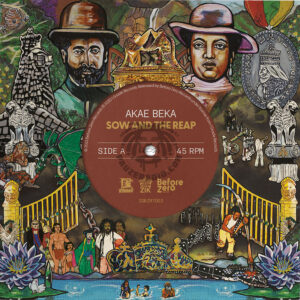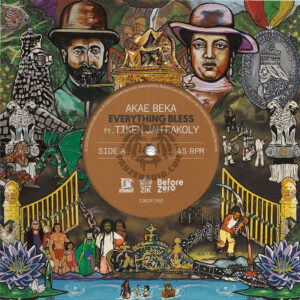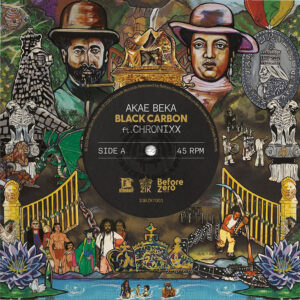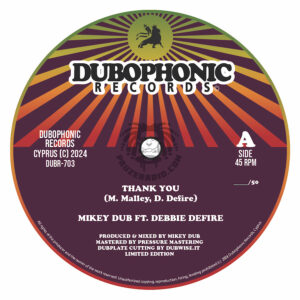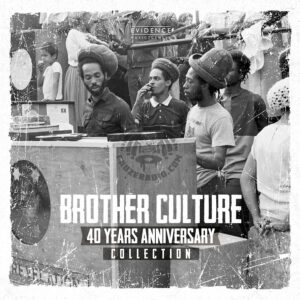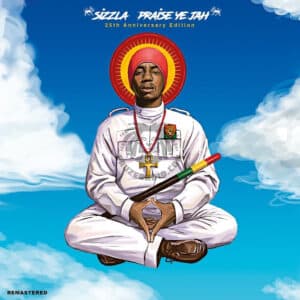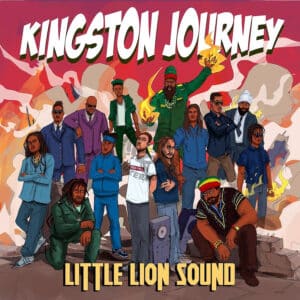
Arky Starch – Dub Faith EP – Review
Arky Starch: Dub Faith EP Review by Mr Topple for Pauzeradio.com.
Belgium-based artist Arky Starch’s personal journey has been underscored by both joy and tragedy. So, the release of his debut EP represents a milestone in this artist’s life. And it’s a wonderful dive into conscious Dub with a heavy dose of genre-smashing to boot.
Arky Starch Dub Faith is a wholly self-constructed and self-released project from Starch. He’s clearly a talented producer, as the EP is cleverly arranged and engineered to give synergy and consistency across its six, Dub-grounded tracks. Mastering by Dubmatix of Renegade Studios is top-class. Moreover, Starch has an ear for Dub engineering – as the prerequisites of a prominent, rich bass coupled with sympathetic focus on the higher kHz instruments has been done well. And all the tracks are very competently composed.
The EP opens with Maximize The Bass – a cut which does what it says on the tin. It’s driven by several factors – not least the more Hip Hop drums, which avoid a one drop by putting the kick on the first and third beats of the bar. Hi-hats perform a rolling, double time rhythm while the snare accents the two and four. This arrangement moves Maximize The Bass into a funkier territory than traditional Dub – aided and abetted by a riffing guitar line. It’s rounded and rich (as opposed to the increased mid and treble amp sound often found on Roots) and drops occasional melodic runs into proceedings. Horns have been arranged like Ska, in both the melodic line (working octaves apart) and the heavily dotted rhythm. But elements of Dub and Roots are still there, like the rasping keys performing a bubble rhythm across the track.
It is, of course, the bass which drives the cut. Sine wave-like in its deep, rounded and kHz-heavy tone, it pulsates across Maximize The Bass. Working across a two-bar drop-beat rhythm, it skips the one on the first, then the two on both – using dotted and crotchet notation. But on the bridge, it breaks out into something more frantic, working across semiquavers. Melodically, the bass runs around root triads, in keeping with older-style Dub. An accompanying, lower register and almost wah-wah’d electric guitar plays a delicious melodic motif at points – and all this makes Maximise The Bass a juicy foray into Dub.
Panic In Da System sees Arky Starch Dub Faith take a more brooding turn and brings in Roots again. High-passed keys run a consistent, stark bubble rhythm. The bass is stripped back, skipping beats two and three and has been engineered to be less prominent than on Maximise The Bass. Again, drums avoid a one drop, with the kick hitting the first and third beats. Hi-hats and snare maintain the fairly pacey BPM well. But central to the track’s dystopian, unsettling vibe is the use of an almost 80s Synthwave selection of synths. Prominent among these are horns: rasping and urgent, they work off a diatonic motif – with Starch using clever engineering to create their tinny sound. Then, there’s an electric guitar. The waveform has been messed with, to lose some of the tininess and instead create a pulsing, rounded sound. He’s added quickly manifesting decay across notes, so the sound peaks and troughs in waves. And the lightest touch of reverb just adds to the unnerving vibe.
But the highlight of the track is a superb bridge. Here, the Roots/Dub vibe is abandoned completely. This instead gives way to something that really is 80s Synthwave/Prog Rock: keys run a countermelody, following the rapid chord progressions. Cymbals crash; an additional electric guitar with the mid and treble amp ratcheted up whines harrowingly, and the bass becomes more urgent. And then, the closing phrases are different again, taking on an almost late 80s funky Hip Hop air with the pounding bass, drum rolls and screeching electric guitar. Glorious yet thought-provoking.
Next, and Only He Will Judge is a more Roots-led track, but with elements of Dub interspersed throughout. Most obvious among this is the appearance of a melodica, which owns the main melodic line. It’s been nicely engineered to lose some of the higher kHz sound, creating something slightly warmer and in keeping with the thematic content. The keys bubble rhythm this time sounds like it’s operated by guitars – and the engineering is nicely done, with the pattern at points being heavily reverbed, at others compressed to ‘other room’ level and sometimes being decayed out of existence. There’s a nice touch of pitch altering at points, too – which catches you by surprise. Starch’s arrangement of the bass line across Only He Will Judge is progressive, as well – as it misses the one, coming in on the off directly after it and working across rapid, semiquaver-led rhythms. This gives the track pleasing momentum, and the whole arrangement is confidently pensive, much like its title.
Pull Off The Strings sees Starch build further on the previous Roots flavours and even incorporates some more traditional Afrobeats devices into it. The former is represented by a straight bubble rhythm on the keys; a drop-beat bass and the drum line with the open skinned snares ever-so slightly distorted. But the latter’s influence is highly apparent. A bottle bell synth is the first indicator, which runs a dotted phrase straight from the off. A glissando’ing chime is used sparingly but effectively and reverbed snare rim clicks intersect, too – varying from hitting just the two, to the two plus offs and back again.
But the horn arrangement is perhaps most effective. Starch has orchestrated it with multiple harmonies at some point, with that signature, rapid dotted rhythmic sequence. But at the end of some phrases they revert back to working octaves apart (more in keeping with Ska). These melodic juxtapositions serve to accent the end of the horns’ phrase, which is striking. And the inclusion of some fluttering djembe round the Afrobeats influences off well. Pull Off The Strings is a melting pot of influences, and Starch has used them all to very good effect. Most interesting is that actual strings only appear at the start of the track, heavily compressed and running staccato notes before the vanish into the ether again; much like the metaphorical strings we should pull off ourselves (and possibly our politicians). Cleverly done.
The track Passing The Border is a melancholy but emotive, Dub-heavy and complex affair. Those heavily engineered horns make another return, being the central melodic focus. They run the track’s main melody, at times consisting of one solo sound and at others multiple, harmonising lines. There’s a brilliant bit of engineering too, where Starch has added the most delicate of pitch bending to just one note as the horn’s melodic line rises in register. Another new instrumental feature is an electric organ, which has been used to sometimes replicate the keys’ bubble rhythm, and other times performs a separate melodic riff. Starch’s use of reverb across the track is particularly good – as his attention to detail in terms of altering the rhythmic pattern on it, dependent on the musical phrasing and what effect is desired, is sterling.
There’s a haunting use of male and female voice samples throughout (potentially a reference to the track’s meaning) and the snare rolls add to this somewhat disturbing feeling. But once again, Starch shows his love for an unexpected bridge – as here, it takes us off into an almost Funky Soul arena with all the instruments working off dotted crotchets, creating a sudden wind before frantic tom-toms rattle and a lone male voice calls out; then the track resumes again. It’s a striking and affecting composition, showcasing Starch’s extremely deft engineering. Beautiful.
Arky Starch Dub Faith concludes with The Last Glimp and perhaps best showcases Starch’s abilities as a composer. The drum arrangement stands in contrast with the rest of the EP, being more intricately arranged with additional rolls on tom-toms throughout, as well as the hi-hat/snare pattern and rattling djembe. This, along with the almost African chanting at points, nods to the Motherland. Bass-wise, and again Starch has mixed things up – often avoiding a drop-beat rhythm, instead opting for it to run fully across the bar on a crotchet-dotted semiquaver-semiquaver led phrase. Keys are back with a bubble rhythm, slightly more high-passed and airy, with delicate reverb and waxing and waning decay – making them shimmer anthropomorphically.
But it’s the horns which stand out. They are engineered differently again – this time with a richer, deeper timbre to make them sound wholly natural (as opposed to the rasping, 80s-style used previously). They’re central to the “glimp” theme, as they serve as an almost regal and angelic fanfare, signalling positivity amid the chaos. The Last Glimp’s chord progressions, working from major to minor, enhance this. And again, there’s a pointed bridge which strips away everything that’s come before it, leaving the bass and drums at first, before the rhythm drops away into a brief improv section – allowing the individual lines to come back in before the beat kicks once more. It’s a stunning and moving arrangement, and a fitting closing to an EP which crosses numerous thematic and emotional boundaries to finish on something positive and uplifting.
Starch’s engineering and production are extremely good. Not least among this is the overall timbre across all the tracks. He has managed to recreate that saturated, almost overloaded analogue sound that harks back to the genre’s Sound System days. Whether or not this was naturally created or done via the use of a plug-in is unclear. But it’s there and it’s good to hear.
Moreover, he has also created a wonderful narrative that runs through Dub Faith. From the opening track, summing up the essence and meaning of Dub (plus a nice bit of musical anthropomorphism – the bass being our voices); the social commentary of Panic In Da System and its musical response (and resolution for those who are conscious) in Only He Will Judge; the self-affirming Pull Off The Strings, breaking the fear and shackles of the system; Passing The Border (which feels very personal and autobiographical) to its shimmering, positive conclusion The Last Glimp and the ray of hope it offers. There’s a distinct story which runs across the EP – and Starch has delivered it with aplomb.
Dub Faith is an extremely well-crafted project from Starch. Not only is it musically joyous but also technically adept as well. And for an instrumental EP the smart yet searing narrative he has created is powerful and accessible. It represents a pivotal moment in Starch’s life and career – and the latter will surely blossom after this. Excellent. Read the press release for Arky Starch Dub Faith EP here.
Arky Starch Dub Faith EP review by Mr Topple (9th August 2020).





